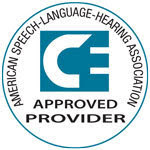By Carmen Wilson
 Texas-licensed speech language pathologists have a license renewal every two years with a birth month deadline. Twenty (20) hours of continuing education (30 if dual licensed) are required for licensure.
Texas-licensed speech language pathologists have a license renewal every two years with a birth month deadline. Twenty (20) hours of continuing education (30 if dual licensed) are required for licensure.
There are no limits for online CE if ASHA approved. Two (2) hours of ethics are required at each renewal, jurisprudence exam is required for renewal (one-time requirement) – counts for one hour of the ethics requirement.
Professional Development Resources is approved by the Continuing Education Board of the American Speech-Language-Hearing Association (ASHA Provider #AAUM) to provide continuing education activities in speech-language pathology and audiology. See course page for number of ASHA CEUs, instructional level and content area. ASHA CE provider approval does not imply endorsement of course content, specific products or clinical procedures. CEUs are awarded by the ASHA CE Registry upon receipt of the CEU Participant Form from the ASHA Approved CE Provider. Please note that the completion date that appears on ASHA transcripts is the last day of the quarter, regardless of when the course was completed.
Speech Language Pathologist CE
 |
As the population of the United States ages, more healthcare professionals find themselves treating elders. Schools, private practice, and hospitals will always be major practice settings, but the demographics of our country point to a growing need for geriatric treatment. In 2014 there were an estimated 1.5 million people in 16,000 skilled nursing facilities. By 2030 this number may be as high as 2.6 million. There is a significant need now for treatment provided by speech-language pathologists in the skilled nursing facility setting which will only grow in the years to come.Every practice setting has unique characteristics that affect clinical practice. Skilled nursing facilities have a multitude of regulations, complicated billing practices, and a culture of care that must be learned and integrated into the SLP’s treatment habits. This can make it difficult for the SLP working part-time or PRN in a skilled nursing facility. This course will provide a framework for providing care in a skilled nursing facility. It is intended to give the SLP an overview of the important aspects of long-term care that affect treatment. The average resident and common treatment areas will also be discussed.
|
 |
It is well-established by research that many learners on the autism spectrum benefit from the use of visuals. How can we go beyond a basic use of symbols to create and implement individualized visuals that will help our students learn and communicate more comprehensively? Participants will learn about considerations and strategies to take into account in order to put more effective visuals in place for their students on the autism spectrum. Topics covered include: broadening symbol selection, adding layers and additional components to visuals in order to make them more motivating and meaningful, providing visuals for a wide variety of expressive communicative functions, and using visuals for comprehension and organization as well as expression.The course video is split into 2 parts for your convenience: part 1 is 56 minutes and part 2 is 57 minutes.
|
 |
This is a test only course (book not included). The book (or e-book) can be purchased from Amazon or some other source.This CE test is based on the book “Early Childhood Music Therapy and Autism Spectrum Disorders: Developing Potential in Young Children and their Families” (2012, 304 pages). This text includes the work of many researchers and practitioners from music therapy and related disciplines brought together to provide a comprehensive overview of music therapy practice with young children who present with Autism Spectrum Disorder (ASD). The authors present an overview of ASD including core characteristics, early warning signs, prevalence rates, research and theories, screening and evaluation. The book explores treatment approaches and strategies as applied in music therapy to the treatment of ASD. The authors present a wealth of practical applications and strategies for implementation of music therapy within multi-disciplinary teams, school environments and in family-centered practice.
|
 |
Alzheimer’s dementia is a growing concern among the aging Baby Boomers; yet, modern science points the way to reducing the risks through maintaining a healthy lifestyle. This course is based on a publication from the National Institute on Aging, which describes healthy brain functioning during the aging process and then contrasts it to the processes of Alzheimer’s disease. Full of colorful, detailed diagrams, this educational booklet describes the risk factors for Alzheimer’s disease, effective steps for prevention, strategies for diagnosing and treating Alzheimer’s disease, and the search for new treatments. Strategies for caregivers and reducing caregiver stress are also discussed briefly.
|
Like this:
Like Loading...
 Texas-licensed speech language pathologists have a license renewal every two years with a birth month deadline. Twenty (20) hours of continuing education (30 if dual licensed) are required for licensure.
Texas-licensed speech language pathologists have a license renewal every two years with a birth month deadline. Twenty (20) hours of continuing education (30 if dual licensed) are required for licensure.




